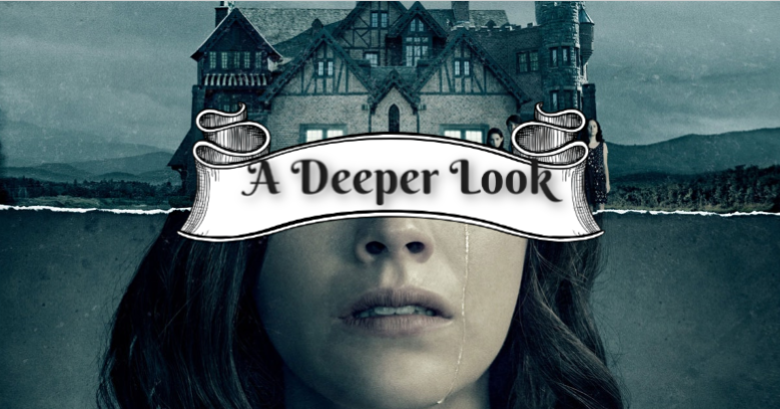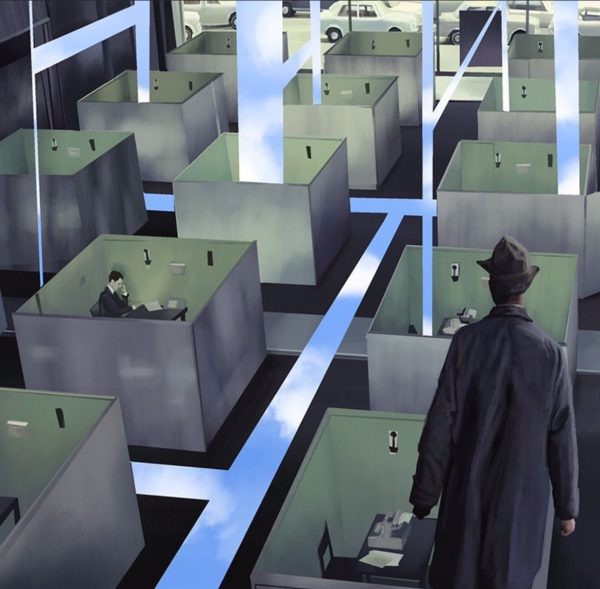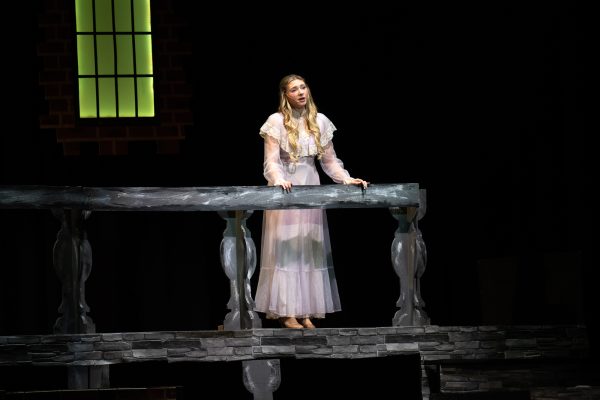A Deeper Look: The Haunting of Hill House
The popular 2018 series may outwardly appear as just a typical horror flick, but the show itself holds a much deeper meaning.
March 1, 2019
*WARNING: Spoilers ahead for the first season of The Haunting of Hill House.*
The end of 2018 was filled with typical Halloween-esque horror flicks, yet one Netflix display in particular, The Haunting of Hill House, swept across the Internet akin to 2019’s Bird Box. Every Netflix-crazed person itching for a horror fix flocked to the show seemingly before it was even released.
While the show itself provided a much needed “fix” in terms of a psychological thriller with well-timed jump scares, sensible plot, and tangible characters, The Haunting of Hill House also touches upon deeper, universal subjects: grief and trauma. The series dives into the notion that grief originates from, specifically, childhood trauma. This would probably be Sigmund Freud’s favorite show.
The “Hill House” can be seen as a metaphor for trauma. Everyone experiences some form of mental distress in their childhood: whether it be financial struggles, divorced parents, illness, death, or even — in the Crains’ case — a haunted house.
The horrors that the Crain children had to endure at such a young age obviously shaped them into the adults they became; this, of course, mirrors the common belief that things people experience in their youth alters their development, for better or worse.
The Crain children, all grown up, are extreme examples of what unexplored trauma can do to a person. All of them appear to take on two or three dominant personality traits that are gradually explained in the many flashbacks throughout the series. Theodora is cold, distant, and selfish; meanwhile, Shirley is the definition of high strung.
At first, it can make the adult characters appear rather tedious — predictable even. However, by piecing one and one together, it becomes apparent that the five Crain siblings actually represent the famous 5 stages of grief: denial, anger, bargaining, depression, and acceptance.
Steven Crain: Denial
Steve Crain, the eldest, takes the cake for being able to produce the insufferable ability to deny absolutely everything. The oldest Crain sibling seems to be unable to accept the events that occurred during his childhood, even if he experienced these incidents himself. Obviously, his house was very much haunted, prompting him to write a best-selling book about his experiences.
Only in his mind, these “experiences” weren’t supernatural. Steve always had some kind of explanation for things, even when he himself witnessed the paranormal. It makes sense that he represents the denial stage, especially when he goes so far as to write a book explaining how all of the paranormal things that happened to him weren’t actually paranormal and that it must have been his siblings or his eyes playing tricks on him.
Being a person who could never get past the first stage of grief meant that Steve had been doomed from the start. When he couldn’t accept these occurrences as reality, he was bound to never get over the trauma of living in a haunted house and the effects it had on his family. Come on, Steve — a ten foot tall floating man looming over your brother’s bedside has nothing to do with your mother’s mental health.
Shirley Crain: Anger
One wrong step and Shirley Crain erupts into a fit of vexation. She’s a sensitive person that has carried on a passionate, fiery attitude towards just about everything. When Steve first publishes his book, Shirley absolutely explodes and goes so far as to call his profits “blood money.” She’s seen as entirely unforgiving, relentlessness, and overall, just one big ball of emotions.
Being older when her family moved into Hill House, Shirley carried her grief into adulthood in a different, more fixated way, which is similar to how anger makes people latch onto things. For one, she owns a mortuary. Not only this, but Shirley has an actual model-size version of her picturesque “dream house” sitting near her dinning room table. The “dream house” was supposed to be the house the Crain’s moved into after fixing up Hill House, and it makes sense that Shirley, the epitome of anger, has gripped onto it.
Taking her anger out on others is also not uncommon for Shirley, which is very similar to the behavior of actual people going through grief.
Theodora “Theo” Crain: Bargaining
Theodora is probably the closest human personification of Slytherin to have ever existed. She’s cunning, hardworking, and resourceful. She even became a doctor for pediatric psychology. However, Theo is incredibly cold. She is known for being emotionally void and obsessed with protecting herself through distance by the use of physical gloves.
The other stages of grief are pretty self-explanatory, but bargaining might need some clarification. Bargaining is a person’s way of attempting to gain control of the situation. By saying things like, “If only we had done something sooner..” or things similar in nature, it gives a person a weak sense of control and often accompanies guilt. It is a line of defense that attempts to protect this person from reality.
Theo directly shows this, even through her profession. She’s a pediatric psychologist; Theo feels as though in order to make right for the past events of her childhood, she should in turn help other children through their own traumas.
Her daily life even makes her stage of grief apparent. She is never seen without her gloves; we later find out Theo experiences telepathic abilities when touching another person’s skin, and her gloves were given to her by her mother. Theo hadn’t realized this “power” of sorts until she lived in Hill House. Therefore, she attempts to hide the effects of Hill House by covering her hands with something that resembles protection: her mother’s love, or, as we see it, the gloves.
Luke Crain: Depression
Luke had arguably been one of, if not the most, affected by the events of his childhood. He and his twin sister, Nell, were the youngest of the family and, as horror flicks usually go, experienced the most. From being stalked by a floating ten foot tall man to getting terrorized by a creature in the basement to almost being poisoned by his own possessed mother, it is no wonder Luke Crain embodies the fourth stage of grief.
He went through a lot, and, as people with depression sometimes do, Luke turned to drugs as a coping mechanism. Of course, drugs don’t help depression. In fact, they make it worse. Therefore, he’s stuck in the fourth stage of grief, having been in and out of rehab multiple times by the show’s present story line.
Luke appears as someone that could just never come to terms with what happened to him as a child, which is a common theme in reality too. Luke’s character hits home for most, as the audience gets to see directly how he was changed from a small thick-rimmed glasses wearing boy to a man that can only come to terms with his past with a needle in his arm. It shows the audience that those who turn to drugs to cope are not just “awful” people, and are, in reality, the ones that need the most help.
Eleanor “Nell” Crain: Acceptance
Nell, the youngest, twin sister of Luke and catalyst to the whole situation, represents the final stage of grief. Acceptance sounds like a positive word, when, in reality, acceptance does not necessarily mean happiness. To accept something does not mean one is okay with it; they’re simply recognizing its established existence.
Young Nell also went through a whirlwind of terrors in the house. The main antagonist was the infamous “Bent-Neck Lady,” who terrorized Nell when she slept at night. Later on, it’s revealed that Nell was actually going through sleep paralysis, and that, due to the house’s (confusing) non-linear time frame, Nell was also seeing her future self.
When the series begins, the audience doesn’t get to see Nell alive and well. However, through the childhood and recent flashbacks, it is apparent that Nell is the most rooted out of all the siblings. She appears to be the one to have a handle on things more so than her siblings. This makes sense, for she was in the last stage of grief.
Nell had been the one to reach out to her siblings, to check up on them, and to try and keep the family together. The fifth stage of grief is pulling oneself back together and coming to terms with things the way they are.
Steve has his book, Shirley has her “perfect house,” and Theo has her gloves. Luke, common to depression, has nothing physical to hold on to, and he instead holds onto his anguishing memories. This comes in the form of the ten foot tall man that, similar to Nell’s bent-neck lady, still stalks Luke in his adult days. Unlike the others, however, Nell goes back to the house to confront her trauma and round off the final stage of grief.
What happens to her was purely for plot purposes, and we can see in the very last episode that she then fills her role to bring her siblings towards the fifth stage.
The show definitely does a better job at exhibiting how each character deals with their grief compared to an analytical article. The message that The Haunting of Hill House conveys is nothing short of complicated. There’s so many themes, plots, and points that it can be a little confusing to fully digest while watching the show.
Thankfully, Netflix has just confirmed there will be a second season of the show. However, it will be renamed The Haunting of Bly Manor. Instead of focusing on the Crain family, Netflix says there will be an entirely new cast with all new scares, ghosts, and traumas to be seen.















Katherine • Nov 7, 2021 at 9:27 pm
I can see the logic for all of these characters as stages of grief, but I would reverse the roles for Shirley and Theo. If anything, it feels like Shirley’s strict need for control and work as a mortician is a form of bargaining with death, while Theo’s callousness feels like cold, bitter anger.
As well, at the news of Nellie’s death, Theo explicitly says that she is angry. She blames Nell for it, that she should have known better.
At the same time, I can understand how she is bargaining with her past at Hill House. She neither embraces it nor hides from it. Uses the powers she learned there when she deems it necessary, and wears gloves at all other times. But I can’t help but feel she resents Hill House and only uses her gift begrudgingly.